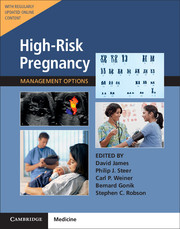Book contents
- Frontmatter
- Contents
- List of Contributors
- Preface
- Section 1 Prepregnancy Problems
- Section 2 Early Prenatal Problems
- Section 3 Late Prenatal – Fetal Problems
- 9 Prenatal Fetal Surveillance
- 10 Fetal Growth Disorders
- 11 Disorders of Amniotic Fluid
- 12 Fetal Hemolytic Disease
- 13 Fetal Thrombocytopenia
- 14 Fetal Cardiac Arrhythmias
- 15 Fetal Cardiac Abnormalities
- 16 Fetal Craniospinal and Facial Abnormalities
- 17 Fetal Genitourinary Abnormalities
- 18 Fetal Gastrointestinal and Abdominal Abnormalities
- 19 Fetal Skeletal Abnormalities
- 20 Fetal Tumors
- 21 Fetal Hydrops
- 22 Fetal Death
- Section 4 Problems Associated with Infection
- Section 5 Late Pregnancy – Maternal Problems
- Section 6 Late Prenatal – Obstetric Problems
- Section 7 Postnatal Problems
- Section 8 Normal Values
- Index
21 - Fetal Hydrops
from Section 3 - Late Prenatal – Fetal Problems
- Frontmatter
- Contents
- List of Contributors
- Preface
- Section 1 Prepregnancy Problems
- Section 2 Early Prenatal Problems
- Section 3 Late Prenatal – Fetal Problems
- 9 Prenatal Fetal Surveillance
- 10 Fetal Growth Disorders
- 11 Disorders of Amniotic Fluid
- 12 Fetal Hemolytic Disease
- 13 Fetal Thrombocytopenia
- 14 Fetal Cardiac Arrhythmias
- 15 Fetal Cardiac Abnormalities
- 16 Fetal Craniospinal and Facial Abnormalities
- 17 Fetal Genitourinary Abnormalities
- 18 Fetal Gastrointestinal and Abdominal Abnormalities
- 19 Fetal Skeletal Abnormalities
- 20 Fetal Tumors
- 21 Fetal Hydrops
- 22 Fetal Death
- Section 4 Problems Associated with Infection
- Section 5 Late Pregnancy – Maternal Problems
- Section 6 Late Prenatal – Obstetric Problems
- Section 7 Postnatal Problems
- Section 8 Normal Values
- Index
Summary
Introduction
The pathophysiology of immune and nonimmune fetal hydrops is multifactorial and complex. Fetal hydrops is a sign, not a diagnosis, and should prompt the question “What is the cause?”
The fetal component signs of hydrops, usually identified by ultrasound imaging, are:
• skin edema (usually over the cranium), and/or
• the presence of other serous effusion collections (ascites, pericardial, hydrothorax), and/or
• polyhydramnios, and/or
• increased placental thickness (> 6 cm in depth)
In addition to the fetal morbidity and mortality associated with fetal hydrops, a secondary maternal “mirror syndrome” can occur, with findings of:
• maternal dilutional anemia
• edema
• proteinuria
• hypertension
Fetal hydrops is conventionally divided into two etiologic groups:
• Immune fetal hydrops (IFH): ultrasoundidentified fetal hydrops with detection of circulating antibodies in the maternal serum directed against red blood cell (RBC) antigens
• Nonimmune fetal hydrops (NIFH): ultrasoundidentified fetal hydrops with an absence of circulating RBC antibodies in the maternal serum
IFH now accounts for only 10–15% of all cases of fetal hydrops. The incidence has decreased significantly since the introduction of preventative antenatal prophylaxis programs directed against rhesus D (RhD) red cell antigen isomimmunization. This commonly involves administration of anti-D immunoglobulin at 28 weeks for all RhD-negative pregnant women, and postpartum administration of anti-D for RhD-negative women with an RhD-positive newborn. The other RBC surface antigens that cause IFH do not have a directed immunoglobulin prophylaxis treatment available. Thus, they now comprise a greater proportion of IFH cases. The red cell antigens that are particularly common in this respect are antigens E, c, and Kell. Antigens FYa (Duffy) and JKa (Kidd) present much less commonly.
NIFH comprises 85–90% of total fetal hydrops cases. The causes include genetic (recessive or dominant inheritance, or chromosomal abnormalities), structural malformations, infection, metabolic causes, and monochorionic twin placental vascular anomalies.
Perinatal mortality and morbidity for fetal hydrops is high irrespective of the cause. Prenatal fetal therapy for IFH using intrauterine transfusion has been very successful in reducing the incidence of perinatal mortality when initiated early in the pathophysiological process. The management options for IFH are discussed in Chapter 12.
- Type
- Chapter
- Information
- High-Risk Pregnancy: Management OptionsFive-Year Institutional Subscription with Online Updates, pp. 539 - 567Publisher: Cambridge University PressFirst published in: 2017



